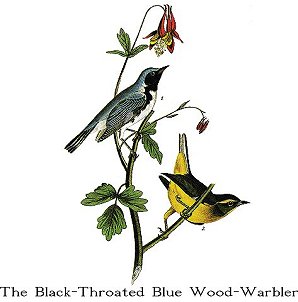
| Family VIII. SYLVICOLINAE. WOOD-WARBLERS. GENUS II. SYLVICOLA, Swains. WOOD-WARBLER. |
Next >> |

Family |
THE BLACK-THROATED BLUE WOOD-WARBLER. [Black-throated Blue Warbler.] |
| Genus | SYLVICOLA CANADENSIS, Linn. [Dendroica caerulescens.] |
I have met with this species in every portion of the Southern and Western
States, where, however, it is seen only in the early part of spring and in
autumn, on its passage to and from its summer residence. In South Carolina it
arrives about the 25th of March, and becomes more abundant in April; but it has
left that country by the 10th of May. During its stay there, it keeps in deep
woods, where it may be seen passing among the boughs, at a height of from ten to
twenty feet from the ground.
Proceeding eastward, we find it more numerous, but residing only in the
depths of the morasses and swampy thickets. I saw many individuals of the
species in the Great Pine Forest of Pennsylvania, after which I traced it
through the upper parts of the State of New York into Maine, the British
Provinces, and the Magdeleine Islands, in the Bay of St. Lawrence. In
Newfoundland I saw none, and in Labrador only a dead one, dry and shrivelled,
deposited like a mummy in the fissure of a rock, where the poor bird had fallen
a victim to the severity of the climate, from which it had vainly endeavoured to
shelter itself.
I am indebted to the generous and most hospitable Dr. MACCULLOCH of Halifax
for the nest and eggs of this Warbler, which had been found by his sons, who are
keen observers of birds. The nest is usually placed on the horizontal branch of
a fir-tree, at a height of seven or eight feet from the ground. It is composed
of slips of bark, mosses, and fibrous roots, and is lined with fine grass, on
which is laid a warm bed of feathers. The eggs, four or five in number, are of
a rosy tint, and, like those of most other Sylviae, scantily sprinkled with
reddish-brown at the larger end. Only one brood is raised in a season. The
young, when fully fledged, resemble their parents in the colours of their
plumage, which, however, is mixed with duller tints, the differences indicative
of the sex being already observable.
The Black-throated Blue Warbler is an expert catcher of flies, pursues
insects to a considerable distance in all directions, and in seizing them snaps
its bill so as to produce a clicking sound. It now and then alights on a low
plant, such as that represented in the plate, and moves along the branches
searching for pupae, ants, and insects. I have never heard its love-song, but
its common note is a rather melancholy cheep. I am inclined to believe that it
breeds in the State of Maine, having seen several individuals of both sexes not
far from Eastport, in the beginning of June 1833, when several other species had
nests.
The birds represented in Plate 148 of my large edition as Sylvia sphagnosa,
are the young of the Black-throated Blue Warbler, the female of which resembles
them so much that I looked upon it as of a species distinct from the male. I
have no doubt that this error originated with WILSON, who has been followed by
all our writers. Now, however, the Sylvia or Sylvia sphagnosa of BONAPARTE,
which he altered from WILSON's S. pusilla, must be erased from our Fauna. This
bird extends to the head waters of the Missouri, but is not mentioned as
occurring in the Fur Countries. I found it abundant on my way to the Texas in
the beginning of April; I have also seen it plentiful in June about Boston,
where, however, it does not breed. Of this fact also I gave the first
intimation to the Prince of MUSIGNANO.
MOTACILLA CANADENSIS, Linn. Syst. Nat., vol. i. p. 334.
BLACK-THROATED BLUE WARBLER, Sylvia canadensis, Wils. Amer. Orn.,
vol. ii. p. 115. Male.
SYLVIA CANADENSIS, Bonap. Syn., p. 84. Male.
BLACK-THROATED BLUE WARBLER, Sylvia canadensis, Nutt. Man.,
vol. i. p. 398. Male.
BLACK-THROATED BLUE WARBLER, Sylvia canadensis, Aud. Orn. Biog.,
vol. ii. p. 309. Male.
PINE-SWAMP WARBLER, Sylvia pusilla, Wils. Amer. Orn.,
vol. v. p. 100. Young.
SYLVIA SPHAGNOSA, Bonap. Syn., p. 85. Young.
PINE-SWAMP WARBLER, Sylvia sphagnosa, Nutt. Man.,
vol. i. p. 406. Young.
PINE-SWAMP WARBLER, Sylvia sphagnosa, Aud. Orn. Biog.,
vol. ii. p. 279. Female and Young. Vol. v. p. 458.
Wings rather long, with the third quill longest, the second almost equal,
the fourth longer than the first; tail even. Male dull light blue above, white
beneath; frontal band, cheeks, throat, and sides, black; a white patch on the
wing formed by the bases of the primaries; outer three tail-feathers with a
patch of white on the inner web near the end, all the rest with a touch of the
same. Female greenish-olive above, light dull yellow below, with a less
extended white patch on the wing, the white on the tail unconspicuous. Young
similar to the female.
Male, 5, 7 1/2.
From Texas northward. Migratory. Abundant.
THE CANADIAN COLUMBINE.
AQUILEGIA CANADENSIS, Willd., Sp. Pl., vol. ii. p. 1247.
Pursch., Flor. Amer. Sept., vol. ii. p. 372.
--POLYANDRIA PENTAGYNIA, Linn.--RANUNCULACEAE, Juss.
This species, which has the flowers of a bright red mixed with yellow, and
is characterized by having the horns of the nectaries or petals straight, grows
in the crevices of rocks, and in dry places near rivulets.
| Next >> |